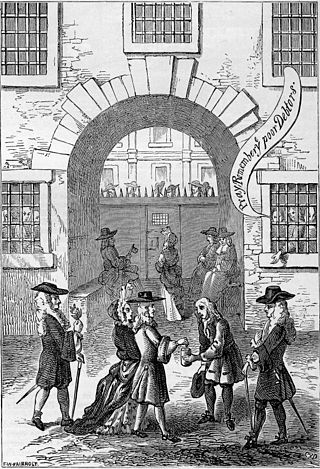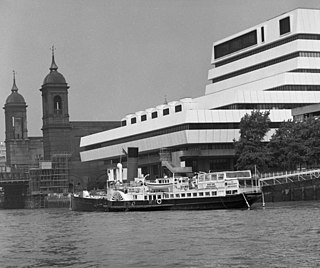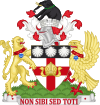BT Group plc is a British multinational telecommunications holding company headquartered in London, England. It has operations in around 180 countries and is the largest provider of fixed-line, broadband and mobile services in the UK, and also provides subscription television and IT services.

Clerkenwell is an area of central London, England.

Holborn is a district in central London, which covers the south-eastern part of the London Borough of Camden and a part of the Ward of Farringdon Without in the City of London.

Vauxhall is a district in South West London, part of the London Borough of Lambeth, England. Vauxhall was part of Surrey until 1889 when the County of London was created. Named after a medieval manor, "Fox Hall", it became well known for the Vauxhall Pleasure Gardens.

Smithfield, properly known as West Smithfield, is a district located in Central London, part of Farringdon Without, the most westerly ward of the City of London, England.
Millbank is an area of central London in the City of Westminster. Millbank is located by the River Thames, east of Pimlico and south of Westminster. Millbank is known as the location of major government offices, Burberry headquarters, the Millbank Tower and prominent art institutions such as Tate Britain and the Chelsea College of Art and Design.

Lambeth is a district in South London, England, in the London Borough of Lambeth. Lambeth was an ancient parish in the county of Surrey. It is situated 1 mile south of Charing Cross. The population of the London Borough of Lambeth was 303,086 in 2011. The area experienced some slight growth in the medieval period as part of the manor of Lambeth Palace. By the Victorian era the area had seen significant development as London expanded, with dense industrial, commercial and residential buildings located adjacent to one another. The changes brought by World War II altered much of the fabric of Lambeth. Subsequent development in the late 20th and early 21st centuries has seen an increase in the number of high-rise buildings. The area is home to the International Maritime Organization. Lambeth is home to one of the largest Portuguese-speaking communities in the UK, and is the second most commonly spoken language in Lambeth after English.

County Hall is a building in the district of Lambeth, London that was the headquarters of London County Council (LCC) and later the Greater London Council (GLC). The building is on the South Bank of the River Thames, with Westminster Bridge being next to it, to the south. It faces west toward the City of Westminster and is close to the Palace of Westminster. The nearest London Underground stations are Waterloo and Westminster. It is a Grade II* listed building.

Fleet Prison was a notorious London prison by the side of the River Fleet. The prison was built in 1197, was rebuilt several times, and was in use until 1844. It was demolished in 1846.

Bridewell Palace in London was built as a residence of King Henry VIII and was one of his homes early in his reign for eight years. Given to the City of London Corporation by his son King Edward VI for use as an orphanage and place of correction for wayward women, Bridewell later became the first prison/poorhouse to have an appointed doctor.

Victoria is an area of Central London in the City of Westminster. It is named after Victoria Station, which is a major transport hub. The station was named after the nearby Victoria Street.
This article shows the development timeline of telephone companies in Birmingham, England.

Ludgate Circus is a road junction in the City of London where Farringdon Street/New Bridge Street crosses Fleet Street/Ludgate Hill.

The Hyde is a locality in the London Borough of Barnet in London, England, and is also the name of its accompanying main road on the A5. It is located to the east of Kingsbury, west of Hendon and south of Colindale. The area contains Hyde House, Hendon Magistrates' Court, a large Sainsbury's supermarket, Silkbridge Retail Park, and BT Colindale House telephone exchange. The area is considered a part of Colindale.
Stag Lane Aerodrome was a private aerodrome between 1915 and 1933 in Edgware, north London, UK.

The BT Centre in London was until 2021 the global headquarters and registered office of BT Group. It occupied a 10-storey office building on Newgate Street in the City of London, opposite St Paul's tube station. It was opened in June, 1984.

The General Post Office (GPO) was the state postal system and telecommunications carrier of the United Kingdom until 1969. Before the Acts of Union 1707, it was the postal system of the Kingdom of England, established by Charles II in 1660. Similar General Post Offices were established across the British Empire. In 1969 the GPO was abolished and the assets transferred to The Post Office, changing it from a Department of State to a statutory corporation. In 1980, the telecommunications and postal sides were split prior to British Telecommunications' conversion into a totally separate publicly owned corporation the following year as a result of the British Telecommunications Act 1981. For the more recent history of the postal system in the United Kingdom, see the articles Royal Mail and Post Office Ltd.
Dorothy Annan was an English painter, potter and muralist who was born in Brazil to British parents and was educated in France and Germany. Her works were frequently shown at the Leicester Galleries in London and she had her first solo show there in 1945.

The Congregational Memorial Hall in Farringdon Street, London was built to commemorate the 200th anniversary of Great Ejection of Black Bartholomew's Day, resulting from the 1662 Act of Uniformity which restored the Anglican church. The two thousand puritan ministers who refused to take the oath of conformity thereby established non-conformism.

Mondial House was a main telecommunications hub in central London on the banks of the River Thames. It was known as an international switching centre (ISC). Built in 1978 the building was seen as controversially modern-looking. It was demolished in 2006.



















